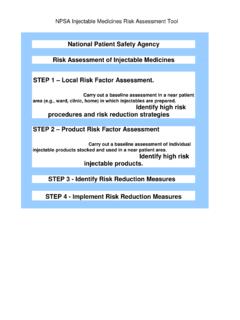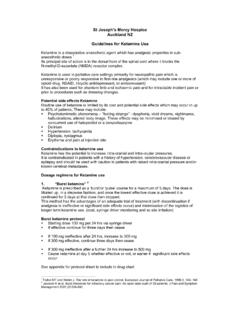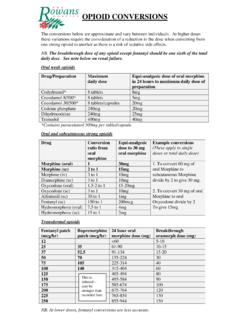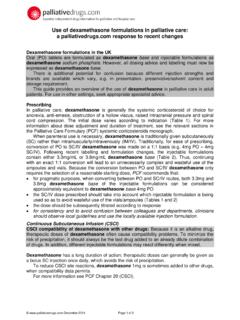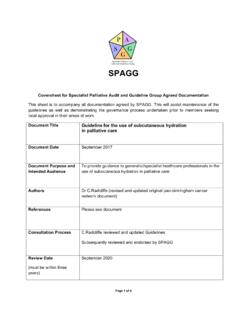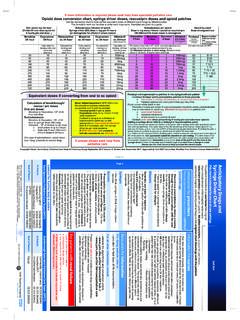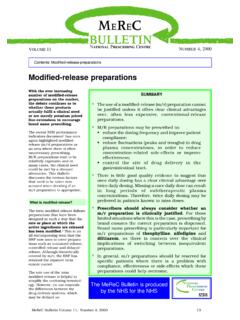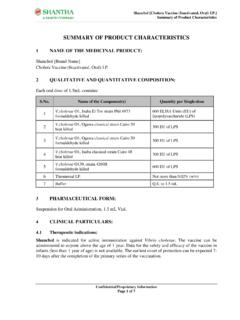Transcription of SUMMARY OF PRODUCT CHARACTERISTICS - © …
1 SUMMARY OF PRODUCT CHARACTERISTICS 1. Name of the medicinal PRODUCT OxyNorm 10 mg/ml, solution for injection or infusion 2. Qualitative and Quantitative Composition Oxycodone hydrochloride 10 mg/ml (equivalent to 9 mg/ml oxycodone) For excipients, see section 3. Pharmaceutical Form Solution for injection or infusion. 4. Clinical Particulars Therapeutic indications For the treatment of moderate to severe pain in patients with cancer and post-operative pain. Posology and method of administration Route of administration: Subcutaneous injection or infusion Intravenous injection or infusion.
2 Posology: The dose should be adjusted according to the severity of pain, the total condition of the patient and previous or concurrent medication. Adults over 18 years: The following starting doses are recommended. A gradual increase in dose may be required if analgesia is inadequate or if pain severity increases. (Bolus): Dilute to 1 mg/ml in saline, 5% dextrose or water for injections. Administer a bolus dose of 1 to 10 mg slowly over 1-2 minutes. Doses should not be administered more frequently than every 4 hours. (Infusion): Dilute to 1 mg/ml in saline, 5% dextrose or water for injections.
3 A starting dose of 2 mg/hour is recommended. (PCA): Dilute to 1 mg/ml in saline, 5% dextrose or water for injections. Bolus doses of mg/kg should be administered with a minimum lock-out time of 5 minutes. (Bolus): Use as 10 mg/ml concentration. A starting dose of 5 mg is recommended, repeated at 4-hourly intervals as required. (Infusion): Dilute in saline, 5% dextrose or water for injections if required. A starting dose of mg/day is recommended in opioid na ve patients, titrating gradually according to symptom control. Cancer patients transferring from oral oxycodone may require much higher doses (see below).
4 Transferring patients between oral and parenteral oxycodone: The dose should be based on the following ratio: 2 mg of oral oxycodone is equivalent to 1 mg of parenteral oxycodone. It must be emphasised that this is a guide to the dose required. Inter-patient variability requires that each patient is carefully titrated to the appropriate dose. Elderly: Elderly patients should be treated with caution. The lowest dose should be administered with careful titration to pain control. Patients with renal and hepatic impairment: Patients with mild to moderate renal impairment and/or mild hepatic impairment should be treated with caution.
5 The lowest dose should be given with careful titration to pain control. Children under 18 years: There are no data on the use of OxyNorm injection in patients under 18 years of age. Contraindications OxyNorm injection is contraindicated in patients with known hypersensitivity to oxycodone or any of the other constituents; respiratory depression; head injury; paralytic ileus; acute abdomen; chronic obstructive airways disease; cor pulmonale; chronic bronchial asthma; hypercarbia; moderate to severe hepatic impairment; severe renal impairment (creatinine clearance < 10 ml/min); chronic constipation; concurrent administration of monoamine oxidase inhibitors or within 2 weeks of discontinuation of their use; pregnancy.
6 Special warnings and precautions for use The major risk of opioid excess is respiratory depression. As with all opioids, a reduction in dosage may be advisable in hypothyroidism. Use with caution in patients with raised intracranial pressure, hypotension, hypovolaemia, toxic psychoses, diseases of the biliary tract, inflammatory bowel disorders, prostatic hypertrophy, adrenocortical insufficiency, acute alcoholism, delerium tremens, pancreatitis, chronic renal and hepatic disease or severe pulmonary disease and debilitated, elderly and infirm patients. OxyNorm injection should not be used where there is a possibility of paralytic ileus occurring.
7 Should paralytic ileus be suspected or occur during use, OxyNorm injection should be discontinued immediately. The patient may develop tolerance to oxycodone with chronic use and require progressively higher doses to maintain pain control. The patient may develop physical dependence in which case an abstinence syndrome may be seen following abrupt cessation. Oxycodone has an abuse liability similar to other strong opioids and should be used with caution in opioid dependent patients. Interactions with other medicinal products and other forms of interaction There is an enhanced CNS depressant effect with drugs such as tranquillisers, anaesthetics, hypnotics, sedatives, alcohol, muscle relaxants and antihypertensives.
8 Monoamine oxidase inhibitors are known to interact with narcotic analgesics, producing CNS excitation or depression with hypertensive or hypotensive crisis. Oxycodone is metabolised in part via the CYP2D6 and CYP3A4 pathways. While these pathways may be blocked by a variety of drugs, such blockade has not yet been shown to be of clinical significance with this agent. Pregnancy and lactation The effect of oxycodone in human reproduction has not been adequately studied. No studies on fertility or the post-natal effects of intrauterine exposure have been carried out. However, studies in rats and rabbits with oral doses of oxycodone equivalent to 3 and 47 times an adult dose of 160 mg/day respectively, did not reveal evidence of harm to the foetus due to oxycodone.
9 OxyNorm injection is not recommended for use in pregnancy. Oxycodone may be secreted in breast milk and may cause respiratory depression in the newborn. Oxycodone should therefore not be used in breast-feeding mothers. Effects on ability to drive and use machines Oxycodone may modify patients reactions to a varying extent depending on the dosage and individual susceptibility. Therefore patients should not drive or operate machinery, if affected. Undesirable effects Adverse drug reactions are typical of full opioid agonists. Tolerance and dependence may occur. Constipation may be prevented with an appropriate laxative.
10 If nausea or vomiting are troublesome, oxycodone may be combined with an antiemetic. Common (incidence of 1%) and uncommon (incidence of 1%) adverse drug reactions to oxycodone are listed in the table below. Body System Common Uncommon Gastrointestinal Constipation Biliary spasm Nausea Dysphagia Vomiting Eructation Dry mouth
